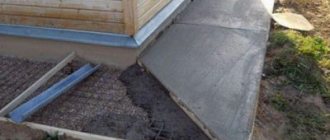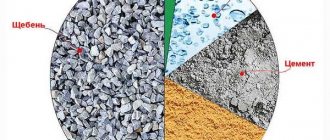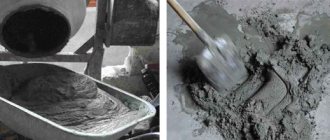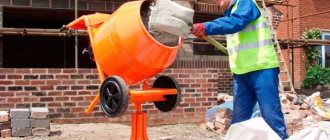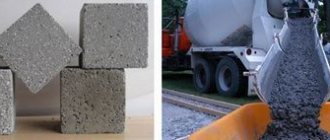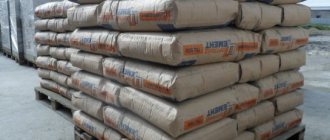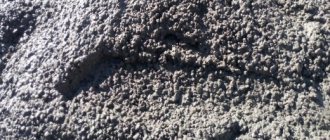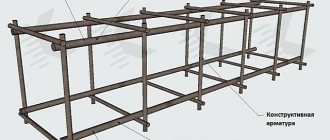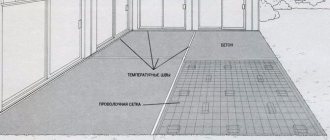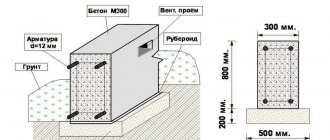The basis of any structure is its foundation. It must be reliable and durable. Only in this case will the building last for a long time. At the beginning of construction, it is necessary to correctly select the composition of cement that will be used and calculate the proportions of concrete for the foundation.
The grade of concrete is formed in accordance with the ratio of the components included in its composition, as well as such indicators as plasticity during laying. The consistency of the solution depends on the amount of water used in its preparation. The proportion of ingredients can be determined by their weight or volume. The most commonly used quantity of components is calculated using a scale or a bucket.
Composition of foundation concrete
Concrete is a mixture of binder and aggregate, which are diluted with a certain amount of water. To improve its quality, additional ingredients can be added to it.
Cement
This is the main component, the quantity of which determines the consistency. Several types of cement are known. Among the most frequently used are the following:
- Portland cement . The cement hardening time begins no earlier than 45-50 minutes after mixing it. The solution finally hardens after 5-10 hours.
- Portland slag cement . After preparing the solution, it begins to harden within 1-6 hours, depending on the air temperature or cement parameters.
- Pozzolanic . The hardening time occurs after 1-4 hours, and the cement finally hardens after 6-13 hours.
- Aluminous . Hardens in 60 minutes, and completely hardens no later than after 8 hours.
The type of cement depends on the components included in it.
Fillers
They determine the main volume of the solution. Regardless of the brand of concrete for the foundation, it includes the following aggregates:
- Sand . It is preferable to use sand after cleaning. The size of its fractions ranges from 1 to 4 mm. It is recommended to use sea, quarry or river sand that has previously been purified (separation of large fractions).
- Gravel and crushed stone . The strength of the solution depends on their quantity. When preparing the mixture, it is recommended to use raw materials with fraction sizes from 7 to 40 mm. The adhesion index increases as a result of the roughness of the components.
- Water . This is a mandatory component on which density depends. The use of water from open sources, which contains various impurities, can adversely affect the strength of the mixture.
Each of these components must be used in a certain quantity during the concrete preparation process.
Additional components
Their use is not mandatory, but the presence of modifiers makes it possible to impart certain properties that affect the quality of concrete during the operation of the structure. Among the additional components that are used more often than others are the following:
- Components that have the property of accelerating or slowing down the hardening process of the solution.
- Plasticizers.
- Superplasticizers.
- Components that impart the ability to withstand low temperatures.
When using modifiers, it is important to strictly adhere to the recipe in which the proportions are indicated. This is due to the fact that excessive amounts of additional ingredients can adversely affect the concrete integrity.
Main components of concrete
The composition of concrete for the foundation includes only a few components: sand, water, cement and crushed stone. Sometimes plasticizers are introduced to improve the characteristics of the solution. The mixture should be thoroughly mixed. Only then will it be possible to achieve the reliability of the future design.
The strength of the base depends on the quality of the components. In this case, it is not worth saving on the purchase of materials. The use of low-quality components causes the collapse of the structure. Therefore, strict requirements are imposed on materials.
Sand
The modern market offers sand of various fractions and places of origin. The choice should be approached responsibly, since the quality of this component significantly affects the properties of the concrete solution. There are several aspects to pay attention to:
- The sand should not contain clay impurities or other foreign inclusions. This will negatively affect the frost resistance of the future structure.
- It is recommended to give preference to fine river sand. It will be possible to obtain a homogeneous solution from it.
- It is also allowed to use pure quarry or quartz sand.
Experts advise purchasing material with a grain diameter not exceeding 4 cm. This is the optimal value for forming a high-quality concrete mixture.
Plants or insects often get caught in the sand. Such inclusions will negatively affect the design. Therefore, before preparing the solution, it is recommended to sift the sand.
Cement
Cement is the main component of a concrete mixture. It has high astringent properties, due to which, after the solution hardens, a strong monolithic structure is formed. There are several types of cement.
| Image | Name | Description |
| Portland cement | Used for the construction of facilities operated in normal climatic conditions. A base made using Portland cement will have average moisture and frost resistance. | |
| Slag Portland cement | This type of cement is suitable for pouring monolithic foundations in mild climates. The finished structure has good moisture resistance. Portland slag cement mortar will take longer to harden than other types. | |
| Pozzolanic Portland cement | Such cement can only be included in concrete intended for the manufacture of lightly loaded foundations, for example, under an outbuilding. The finished structure can withstand high humidity conditions. But its moisture resistance negatively affects its strength characteristics. |
Any cement has its own brand. The maximum load threshold per 1 square centimeter of surface is encrypted under it. That is, if the packaging of cement bears the designation M200, it means that the load per 1 square centimeter of the foundation should not exceed 200 kg.
To build a house, cement grade M300 is sufficient. If you take low grade material, then the foundation of the building will have poor resistance to loads and the process of its destruction will soon begin. It is allowed to use cement of higher grades, but then the construction of the building will cost much more.
Cement has an expiration date. It is always indicated on the packaging. It is strictly prohibited to make foundation mortar from expired powder.
Crushed stone
The introduction of crushed stone or gravel into the concrete composition allows you to increase the density of the solution. There are a number of requirements for this component:
- The crushed stone must be clean. The presence of foreign impurities in it, and especially clay and earth, is not allowed.
- The stones must have a cross-section not exceeding a quarter of the thickness of the foundation.
- The ideal option would be a combination of grains of different fractions up to 30 mm. This will reduce the number of voids in the solution.
- The grade of crushed stone should be higher than the grade of the finished composition.
Experts do not recommend using flat and angular crushed stone when making concrete for the foundation. This leads to greater consumption of other components, and, consequently, higher construction costs. The ideal option is crushed gravel. It has the optimal shape for making a homogeneous solution.
If there is any doubt about the purity of the crushed stone, it is recommended to pre-clean it. To do this, lay it out and wash it with a strong stream of water from a hose.
Water
Water is required to transform bulk materials into a viscous homogeneous mass. There are no special requirements for it. The only condition is the use of clean water without foreign impurities.
It is not recommended to introduce liquid with a high concentration of salts into concrete. This can lead to an acceleration of corrosion processes occurring on the reinforcement. In such a situation, the foundation will quickly lose its strength.
Water is taken from a tap or a well. If there is no source nearby, the required amount of liquid is brought in a special tank. As a last resort, it is allowed to use river water, but it will first have to be filtered.
Plasticizers
Plasticizers are special additives that change the properties of foundation concrete. They give the composition elasticity and mobility, making it easier to work with. The plasticizer is an optional component of the solution. But its introduction has a number of advantages:
- Reduces cement consumption by an average of 10%.
- Facilitates the process of stirring the solution.
- Prevents the formation of voids in the finished structure.
- Reduces the pore parameters of the material.
- Increases frost resistance.
- Reduces concrete shrinkage.
To produce such additives, polymers, silicones, surfactants or polycarboxylates are used. These components are safe for humans. A plasticizer can impart certain properties to concrete for pouring a foundation, for example, increase its moisture resistance, frost resistance, reduce hardening time, and others.
What brand of concrete is needed for the foundation?
Several brands of concrete are known. Their formation depends on the amount of ingredients that are used in preparing the solution. Among the most commonly used grades of concrete for foundations are the following:
- M 100 . Used at the initial stages of construction work (concrete footing construction). This brand can be used in the construction of fence bases, wooden houses, adjoining and outbuildings.
- M 150 . Designed for the construction of strip foundations or small 1-story buildings, the walls of which consist of cinder blocks or aerated concrete. Excellent for the construction of agricultural and domestic buildings.
- M 200 . Suitable for construction of 1-2 storey houses with light weight floors. This grade is considered structural, which allows it to be used in the production of reinforced concrete structures.
- M 250, M 300 . Designed for the construction of powerful buildings of large area (up to 7 floors) with monolithic type ceilings.
- M 400 . Used for the construction of multi-storey buildings (up to 20 floors).
When determining the grade of concrete, such an indicator as compressive strength is taken into account. This criterion is determined during the testing process. It shows the amount of load that the solution can withstand without compromising its integrity.
Having data on the compressive strength of the mortar, you can choose the brand of dry mixture for constructing the foundation and the type of floor.
Taking into account the characteristics of concrete, it is classified into compression classes.
| Compressive strength class | Strength value (kg\cm²) | Brand |
| AT 5 | 65, 5 | M 75 |
| At 75 | 98, 2 | M 100 |
| AT 10 | 131, 0 | M 150 |
| At 12.5 | 163, 7 | M 150 |
| At 15 | 196, 5 | M 200 |
If the construction of a house is carried out according to a previously drawn up and agreed upon project, it already indicates not only the materials, but also the brand of mortar for constructing the foundation that needs to be used, as well as the constituent components with the proportions that the mortar consists of.
The brand is directly dependent on the materials used in the construction of the walls of the building, as well as the type of soil.
Materials for the mixture.
In order to make concrete for the foundation, you will need:
Water for preparing cement mortar should, if possible, not contain chemicals (fuel oil, gasoline, etc.). Ordinary running water is what you need.
The sand should not be silty or clayey. Fatty substances create films that prevent the components from adhering to each other. Ideally, washed sand goes into the solution, the cleaner the better.
Cement is distinguished by its brand. The most common are M300, M400 and M500. The higher the grade of cement, the higher the quality of the resulting solution, that is, such technical characteristics as compressive and fracture strength.
According to the construction goals and the size of the foundation, a specific brand of cement is selected.
How to make a mortar for the foundation of a cottage proportions.
In order to prepare a solution for the foundation, you will need water, sand, cement, crushed stone, and, if necessary, various additives.
Crushed stone should not be limestone. You should also not add gravel as a filler for cement mortar. It is better to take crushed stone. Its sharp corners and uneven edges cling to each other and thereby increase the strength of the concrete for the foundation. Cement-sand, as well as mortar based on gravel, expanded clay, and other fillers will be less durable and therefore not used in the manufacture of concrete for foundations.
Additives are needed if you need to make a solution under special conditions. For example, when you need to make a solution in frosty weather, or the finished foundation will be partially or entirely in water and exposed to an aggressive environment. Additives are mixed with water according to the instructions on the package. It is worth remembering that any additives lower the grade of concrete.
Proportions, how to calculate cubic capacity
The number of different ingredients determines its brand, as well as such an indicator as plasticity. Each brand of solution requires a specific formulation of its components.
When preparing it yourself, it is difficult to thoroughly follow the exact recipe. As a rule, the following proportions of concrete are used for the foundation:
- 1 share of cement;
- 3 shares of sand;
- 5 shares of crushed stone;
- 0.5 parts water.
Experts recommend that if you prepare different brands yourself, use the following ratio of its ingredients:
| Brand | Volume ratio of components (l) | Weight ratio of components (kg) |
| M100 (cement:sand:crushed stone) | 1:4:6 | 1:4:7 |
| M200 (cement:sand:crushed stone) | 1:8:3 | 1:2:4 |
| M300 (cement:sand:crushed stone) | 1:8:3 | 1:2:3 |
Proportions in buckets
The indicated weight categories for the quantity of each component are considered approximate. This is due to the fact that each of the components may have a different moisture content or may contain fractions of different sizes.
Experienced experts recommend taking into account the fact that 1 bucket (10 l) includes 15 kg of cement, 20 kg of crushed stone and 18 kg of crushed stone.
Proportions in parts
In practice, a variant of the proportions of concrete for the foundation in parts is used.
| Brand | Cement (part) | Crushed stone (part) | Sand (part) | Water (part) |
| M75 | 1 | 6 | 5, 4 | 1, 2 |
| M100 | 1 | 5 | 4 | 1 |
| M 150 | 1 | 4,6 | 3, 6 | 0, 9 |
| M 200 | 1 | 3, 8 | 2, 8 | 0, 7 |
| M 250 | 1 | 3, 3 | 2, 3 | 0, 65 |
Video on how to calculate the volume of concrete for a foundation:
We prepare a solution for pouring the foundation - the ratio of sand and cement.
The choice of concrete proportions used for the foundation is influenced by many factors: soil parameters, expected loads, type of foundation. The basis of cement mortar is cement, sand, crushed stone or gravel and water; its properties directly depend on the quality and uniformity of mixing of the components. Changing the regulated ratios is unacceptable; the slightest errors lead to a decrease in the strength of the foundation and, as a consequence, the risk of destruction of the load-bearing structures of the building.
How to make mortar for the foundation of a house proportions.
Choosing a concrete grade
The main criteria include the geological conditions of the site (relief, level and partial pressure of groundwater on foundation elements, climate, freezing depth), type of foundation, presence or absence of a basement, height of the building and other weight loads. The limiting factor is the work budget; using high-quality types of concrete for the construction of light buildings on summer cottages is not economically feasible. The recommended minimum is:
- M400 – for houses over 3 floors.
- M200-M250 – for frame and panel buildings.
- M250-M300 – for buildings made of wooden beams.
- M300 - for low-rise buildings made of expanded clay, gas silicate or cellular blocks.
- M350-M300 - when building with brick or pouring load-bearing walls made of monolithic concrete.
The specified gradations are relevant when constructing one- or two-story houses; when adding another floor, it is advisable to choose a higher grade. The same applies to ready-made purchased solutions, especially if purchased from an unverified manufacturer. In general, the minimum permissible strength when concreting the foundations of residential buildings on slightly heaving soils is M200; when building on less stable soils, it increases.
Influence of wall structure and soil composition
It is not always advisable to carry out the expensive procedure of calculating the required grade of concrete for construction, for example, during the construction of a summer house. In this case, it is recommended to focus on the practice of experienced builders.
In practice, 3 main brands are used:
- M 200. Used for constructing the foundation of light buildings with walls made of logs, timber, panels or building blocks.
- M 250. It is recommended to use for the construction of the foundations of 1-story buildings with brick walls and concrete floors.
- M 300. Designed for the construction of multi-storey buildings from 2 to 3 floors with brick walls.
When determining the grade, the type of soil and the depth of groundwater are also important. If construction work is carried out on rocky or sandy soils, where groundwater lies below the freezing line, you can focus on the above parameters for using the brand for the foundation.
If groundwater is located close to the surface, as well as the presence of heaving soils at the construction site, it is recommended to opt for a brand with a higher parameter. This is due to the fact that in this case the solution must have a large margin of safety.
What brand should be used to fill the foundation of a one-story and two-story private house?
In practice, the choice of concrete is usually made by grade. The following options can be distinguished:
- M100 (corresponds to class B7.5) , allowing a load of up to 100 kg/cm2. It can only be used in the construction of fences and small outbuildings (garages).
- M150 (B10-B12.5) . It is used in the construction of foundations for outbuildings and small, light residential buildings.
- M200 (B15) . It can be used for one-story residential buildings. Suitable for prefabricated panel structures.
- M250 (B20) . Suitable for one-story and two-story private houses in the manufacture of strip and column foundations. Recommended for the construction of walls made of logs and timber.
- M300 (B22.5) . Any monolithic foundation can be made from it. It is quite suitable for houses with walls made of foam blocks, gas blocks and expanded clay concrete blocks.
- M350 (B25-B27.5) . It is used for all types of one-story houses (including those with brick and stone, heavy walls) and two-story buildings without much weight.
- M400 (B30) . This type of concrete is used in the construction of heavy two-story structures.
Thus, for one-story construction, the most popular is foundation concrete of grades M100-M350, depending on the weight of the structure, and for two-story buildings it is necessary to choose concrete of at least grade M350.
Choosing concrete for different foundations
For different types of bases it is supposed to use different concrete solutions. For a strip foundation, the calculation of the amount of material required is carried out taking into account the length, width and depth of each strip. For example, if the tape is 20 m long, 0.5 m wide and 1.0 m deep, 10 m³ of mortar will be required to construct it.
After preparing the required volume of concrete, the formwork is poured layer-by-layer (every 0.25 cm). Having laid the layer, it needs to be compacted. In order to avoid the accumulation of air inside the concrete layer, reinforcement is stuck into it (at a distance of 1 m).
When constructing a columnar foundation, calculations of the amount of concrete are performed similarly. However, the formwork is poured not in layers, but at a time. Finally, the solution is compacted.
Manufacturing method
So, when the proportions are clear, you can proceed directly to practice. You can prepare it with your own hands in two well-known ways - manual and mechanized. The first method is to simply mix the starting components with a shovel in a suitable container.
The method is quite labor-intensive and requires great physical strength. The second is using a portable stirrer. This method is less labor-intensive, but requires additional financial investments - to purchase a mixer.
Manual method
It is better to prepare the material using this method when the total volume of the foundation is small. For example, this could be a columnar base for a porch, terrace, shed or small extension to a house, as well as a shallow, narrow strip of several meters around the perimeter.
- Preparation. It is necessary to prepare in advance not only all the necessary material (cement, sand, crushed stone, a source of water), but also a container suitable for mixing the components (this can be a low trough or a bathtub with a volume of about 100 liters) and tools. The latter can be played by an ordinary bayonet shovel. You will also need a shovel to load the finished material into the formwork.
Note! The table presented above shows the final volume of a given brand that will be obtained from 10 liters of cement. Based on these data, you can select a container for manual kneading. However, it is better to take a container with a spare capacity - 10-20 liters larger than the finished volume for ease of mixing.
- Mixing components. All measured components must be poured into a container. Then mix them with a shovel until as homogeneous as possible using the manual method.
- Adding water. In order not to get an excessive amount of it in the finished mixture when adding water, and not to disturb the consistency (in other words, not to spoil it with water), you need to add water in small portions while stirring until the desired consistency is achieved.
Note! The density of the finished solution is determined by its response to mechanical stress, provided that the components are completely mixed. For example, if you take a full shovel of concrete with a mound, the good material will not overflow. Also, if you make a sharp cut with a shovel in a mass of freshly prepared concrete, it should not settle immediately, but should hold its shape for a long time.
Recommendations for Concrete Inspection
Concrete parameters can only be accurately determined in a laboratory setting. In addition, the design strength of the mortar is determined only after 28 days after pouring the foundation.
There is a known technique by using which it is possible to determine the approximate indicator of the plasticity of the mixture.
The essence of the technique is that you need to take a small container and fill it with a solution. After this, the container is turned upside down on a flat surface. The flow pattern of concrete indicates its quality.
Preparation of concrete solution
Having decided on the proportions for a specific brand, you can start mixing it. To do this, first of all, prepare all the materials in the quantity required, after which you need to perform the following steps:
- All dry concrete ingredients must be mixed. To do this, sand, cement and crushed stone are mixed in the required proportions and mixed until a homogeneous mass is obtained. This is best done in a manual concrete mixer.
- Next, when the entire mass has become homogeneous, water is gradually added to the container in a small stream until the required viscosity is obtained.
- The consistency of the solution should be homogeneous and resemble thick sour cream.
- The prepared solution should be used within 2 hours.
How to cook with your own hands and in a concrete mixer
If you plan to build a small building that will require a minimal amount of concrete, it is better to prepare it yourself. To do this, you need a small container (bathtub or basin) and a shovel. Take 1 share of cement (500 m), 2.5 shares of gravel and sand. All ingredients are mixed. Make a well in the center of the mixture and pour some water into it. The mixture is gradually stirred and water is added as needed. The consistency of the finished solution should be fluid, not liquid.
For the mechanized method of preparing the solution, a concrete mixer is used. To prepare 1m³ of solution you will need to take 300 kg of cement (M 500), 650 kg of sand, 1150 kg of crushed stone and approximately 160-185 liters of water.
First, sand is poured into a concrete mixer, and then cement is gradually added. The machine turns on, after mixing the entire amount of cement and sand, little by little water is added to the concrete mixer. After the mixture has the consistency of thick sour cream, crushed stone is added to the machine (in portions). Thus, pour all the components into the machine and mix thoroughly.
The solution should be rotated in the machine for 2-3 minutes until it is completely ready.
Preparation of cement mortar to create a foundation.
- Components of cement mortar
- Foundation mortar - proportions
- Methods for preparing foundation mortar
The main component and main material in construction, without which no work can be carried out, is cement. It is used in combination with other fillers to prepare durable cement mortar: thick is used for plaster or brickwork, and liquid is used for formwork or foundations. The required proportions of components are selected depending on how durable and strong you want to make the foundation. In addition to auxiliary materials, it is important to choose the right cement, having first specified its brand.
How to make a mortar for the foundation of a private cottage, proportions.
Strict adherence to the proportions of the concrete mixture is the key to the reliability and durability of the building.
The grade of cement determines its strength, and therefore the strength of the concrete mortar itself.
How much does a cube of concrete cost?
The cost depends on the brand, as well as the quantity of the solution ordered.
| Brand | Price (rub.\m³) |
| M200 | 3 800 |
| M250 | 3 860 |
| M300 | 3 960 |
MAZ or KAMAZ vehicles can hold from 6 to 10 m³ of solution. This volume is sufficient for foundation pouring. The weight of 1 m³ of concrete is approximately 2-4 thousand. The cost of one car with concrete ranges from 20 to 22 thousand rubles.
Application of concrete
Look around: the vast majority of all structures are built on a concrete foundation, but this is not even the most remarkable thing.
- Walls,
- Scenery,
- load-bearing beams and the like are made of concrete or some part of its inclusions.
Taking this fact into account, of course, we can say that this mixture is used in almost all areas of not only construction, but also repairs, laying railways, strengthening dangerous objects, etc.
How to build a toilet in a country house with your own hands: drawings, location, insulation, ventilation, lighting.
Storage plastic septic tanks: advantages and disadvantages, installation features.
Details on how to flush a well with your own hands: causes of blockage, cleaning options, prices.
Since this material has varieties, the choice of which directly depends on the purpose of the object for which it is used and the area of laying, that is, for the foundation, walls or just decoration, then we will talk about the areas of its application in relation to general information, and go deeper - already in subsequent paragraphs.
The main areas of use of the cement mixture are:
- Construction and repair industries;
- Industry;
- Railway works;
- Military industry;
- Design;
- Mining production;
- Energy and oil industries.
Note that in the military, mining and construction fields, as a rule, reinforced materials are used, since it is necessary to give the structure not only strength, but also hardness: a mixture pierced with steel pins gives much less chips and cracks when subjected to strong impact.
Foundation made from broken concrete
One type of solid construction waste is broken concrete. It can be obtained after demolition or dismantling of buildings.
Concrete scrap can be used in the future only after preliminary preparation. To do this, the garbage is divided into soil impurities and construction waste. If the pieces are very large, they are crushed using hydraulic shears or a special grinding machine. Afterwards, pieces of reinforcement are removed using magnetic sectors.
The possibility of using grout when pouring the foundations of small one-story non-residential buildings cannot be ruled out.
Let's sum it up
Making concrete mortar with your own hands is not that difficult. You need to purchase all the material, monitor its quality and choose one or another proportion. It is thanks to its observance that you can obtain a high-quality concrete solution for the foundation, which, after drying, will become strong, durable and reliable. If you decide to build a house with your own hands, then you need to think several times whether to buy a ready-made solution from a company. Some people decide to do everything themselves to be sure of the quality of the raw materials. In any case, you need to weigh the pros and cons, and then make one choice or another. If you have a working concrete mixer, it is better to try your hand at it yourself.
Recommended Posts
Japanese houses made of foam plastic
Babbitt
Laying gypsum decorative stone
Cold bitumen mastic
Polymer concrete: composition, characteristics
What kind of mortar are fireclay bricks placed on?
Concrete from ASG
This type is prepared using a sand-gravel mixture. The difficulty of preparing it yourself is that due to inexperience you can make a mistake with the proportions of concrete for the foundation.
The sand-gravel mixture can be divided into the following types according to the number of ingredients:
- Classical. Consists of 80% sand and 20% granular components.
- Unconventional. 3/4 of its contents consists of gravel.
If you plan to use ASG to prepare foundation concrete, it is recommended to take sand with a fraction size of 30-45% and gravel from 50 to 70%
Calculation of concrete composition
Proportions
To know exactly in what proportion to make the solution, you first need to decide what brand of material will be needed for construction. The table below shows the initial ratio of components in kilograms (liters) - cement, sand and crushed stone - required for the manufacture of material from M100 to M450.
Proportions
The table also shows volumetric proportions - for those who are more accustomed to measuring in liters, based on measuring containers, for example, a 10-liter bucket.
Considering that it is advisable for a private developer to immediately calculate how much cement will be needed for the entire foundation, we present a calculation algorithm using the example of M100 grade mortar, which allows us to determine the proportions for a foundation per 1 cubic meter:
- The table shows that a bucket (10 liters) of M400 cement produces 78 liters of ready-made mortar.
- 1 cubic meter is 1000 liters, so divide 1000 by 78 and get the number of buckets of cement equal to 12.8. What, the same thing - 128 liters.
- Density of Portland cement M400 = 3100 kg/m3. 1 liter of cement in a bag weighs 3.1 kg.
- We multiply 128 liters by 3.1 kg and we get 396 kg.
- Considering that a standard bag of cement weighs 50 kg (plus or minus 1 kg), for 1 cubic meter of M100 grade material for the base you will need 8 packages of M400 grade Portland cement.
Note! If the accuracy in production is not strict, that is, it is possible to produce concrete of an intermediate grade, then using the given algorithm and tabular data you can roughly (in bags) calculate how much cement is required.
Selecting concrete by grade
| Brand | Type of structure |
| M100
| Concrete of this brand is used mainly for foundation supports - pillows. Can also be used for laying garden paths. |
| M150
| The composition is suitable for the foundations of light structures, non-residential buildings, sidewalks and roads. |
| M200
| Its strength is sufficient for the foundation of permanent residential buildings. However, it is better to use it for light or one-story structures. |
| M250
| The solution is used in the construction of low-rise private houses and any utility buildings. |
| M300
| The most commonly used brand for structures of any type. It is used not only in private housing construction, but also on the construction sites of urban high-rise buildings. |
| M400
| Very high quality solution. It is used for the construction of structures that require extremely high foundation strength, for example, railway and highway bridges, industrial workshops. |
| M450
| Concrete of this brand is extremely expensive and is used only for creating high-strength structures, for example, safe deposit boxes, bunkers, and military facilities. |
Concrete for the foundation - monolithic slab
The monolithic slab, which is used in the construction of the foundation, provides the building with a high level of strength and guarantees excellent thermal conductivity. In addition, its installation takes several times less time than when pouring conventional concrete.
The brand of mortar used for a monolithic slab foundation depends on the load that the future building is expected to withstand. The greater the load, the higher the grade of concrete should be.
When constructing a light building with this type of foundation, it is recommended to use M 250. For building a house made of wood or timber, it is better to use M 300. For building a house made of brick, silicate or reinforced concrete, M 350 concrete should be used.
Basic proportions.
When preparing solutions, the working measure is the mass or volume fraction of the binder; the most common and convenient ratios include 1:3:5 (cement, sand, gravel, respectively). The regulated proportions, depending on the required strength of concrete, are:
Final brand of solution
In private construction, it is inconvenient to separately determine the mass of all poured ingredients; a bucket is usually used as a measuring tool. In this case, all fillers are pre-weighed in a dry state. The W/C ratio largely depends on the moisture content of the sand; experienced developers add no more than 80% of the recommended proportion of water during mixing and then, if necessary (the consistency is not sufficiently plastic), pour it in portions. Fiber, PAD and other plasticizers are added to concrete at the very end along with the liquid; their share usually does not exceed 75 g per 1 m3.
Composition and proportions of foundation mortar and concrete.
Preparing the mixture
Concrete is used in almost all areas of construction, when performing repair, construction or restoration work.
You can prepare the mixture for the foundation yourself by combining the components in a concrete mixer, bathtub, or box. When producing artificial material, it is important to follow the technology and proportions of concrete for the foundation.
Industrial production differs from artisanal production in large volumes, and therefore requires the use of special technical equipment. Mechanical preparation of concrete mixture for foundations by specialized enterprises makes it possible to improve properties and quality through additives.
When forming the foundation for building a house, you can use the services of a company that can prepare a concrete mixture using special equipment on the way to the customer.
To make a composition for the foundation with your own hands, you need to correctly determine the quantitative composition of the components. To obtain concrete grade 300 or 400, sand and cement are taken in proportions of 3:1, i.e. for 10 kg of cement you need to take 30 kg of sand, gravel (crushed stone) - 40-50 kg.
In this example, cement, sand, crushed stone weigh 80-90 kg, so 40-45 liters of water will be required to connect the components. You can mix the mixture using a mobile concrete mixer, a shovel or a construction mixer.
Preparation of concrete from a cement-gravel mixture requires adherence to technology. If the solution turns out to be dense, then it must be diluted with water to such a consistency that it can be stirred with a shovel without much effort. The amount of water is affected by the moisture content of the aggregates, so you should not add it all at once. It is better to do this in portions with constant stirring.
It is better to choose the warm season for concreting. At low temperatures, to improve the quality of concrete, you need to heat up the water, otherwise it may lose strength. And also use antifreeze additives.
Classification of concrete
Based on the purpose of the structural material and its specific gravity, the following types of concrete are distinguished:
- especially heavy;
- heavy;
- easy;
- especially light.
The composition with the highest density is used in the construction of nuclear and power plants, with a specific gravity in the range of 500-1800 kg/m³ - for the manufacture of panels and wall blocks. Particularly lightweight (less than 500 kg/m³) is intended for thermal insulation of house facades.
Heavy concrete (1800-2500 kg/m³) is used for the manufacture of prefabricated, monolithic reinforced concrete structures and foundations. Special impurities that are added to improve its technical characteristics increase strength, resistance to overheating, temperature changes, reinforcement corrosion, and moisture.
The main indicator of strength is reflected by the grade or class of concrete.
Solution components
Cement is a powdery binder that can harden in water and in open air. In combination with coarse and fine aggregate, it ensures the strength and reliability of the structure being built.
Cement is obtained by grinding a mixture of clinker, gypsum and special additives in specified proportions. In turn, clinker is a product from the firing of limestone with clay and other components on which the properties and name of cement depend. Depending on the feedstock, the following types of hydraulic binders are distinguished:
- Portland cement:
- Portland slag cement;
- pozzolanic;
- lime;
- plugging;
- sulfate-resistant and others.
When forming a cement-sand mixture (CSM) in order to obtain concrete of a given strength, it is necessary to take into account the strength grade of Portland cement. The following table shows the strength indicators of the material according to the old and new systems:
| Class | Brand | Strength | |
| MPa | kg/cm3 | ||
| At 22.5 | M300 | 22,5 | 300 |
| B 32.5 | M400 | 32,5 | 400 |
| B 42.5 | M500 | 42,5 | 500 |
| B 52.5 | M600 | 52,5 | 600 |
In addition, when choosing a material for preparing concrete with the required characteristics, other properties of cement are taken into account:
- The fineness of grinding directly affects the strength properties of the concrete mixture, especially at the beginning of hardening.
- Density affects the water-cement ratio, and therefore water consumption. To reduce it, while still achieving good workability of the mixture, plasticizing additives are used.
- Frost resistance is especially important when building in winter or in areas with year-round low outside temperatures.
- Crack resistance. This indicator is influenced by such a concept as the uniformity of volume expansion during hardening.
Depending on the components from which cement is made, the above qualities vary within fairly wide limits.
The concrete mixture, which, in addition to cement, includes sand, as well as crushed stone or gravel, is formed depending on the purpose of the composition. What proportions of cement, sand and crushed stone should be contained in it are determined in accordance with the recommendations of GOST 27006 - 86 (1989) “Concrete. Rules for the selection of compositions" and GOST 7473 - 94 "Concrete mixtures. Technical conditions".
For the concrete mixture, sand with a grain size of 1.2-3.5 mm is used. When choosing this component, pay attention to the purity of the material. In order for the prepared cement-sand mixture to be of high quality, the presence of silt and clay particles in the sand should not exceed 5%.
You can check the suitability of sand for use using water. To do this, you need to pour a small amount of the test component into a container, add water and shake the composition. If the liquid is cloudy and contains suspended clay particles, then the sand is not suitable for preparing concrete.
The concrete mixture used to pour the foundation includes crushed stone or gravel of medium fraction. The use of large grains will lead to loss of strength of the foundation for the construction of the building.
The production of high-quality concrete is possible using warm and clean water, without minor impurities (oils, paints).
When preparing a cement-sand mixture, you need to take into account that there are no absolutely pure components. In practice, it can be difficult to accurately calculate the proportion of sand and cement for the foundation, especially when pouring the foundation for individual construction.
Additionally, you need to take into account the fact that over time, foundation cement loses some of its properties. Over six months of storage, the material reduces its binding properties by a third. Accordingly, the grade characterizing the compressive strength is reduced.

